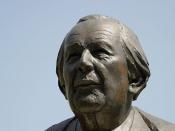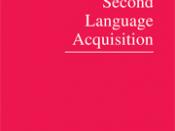To someone unfamiliar with the concept of child language acquisition, it would be easy to assume that the basis of learning speech is merely by the duplication of vocabulary and sentence structure heard around the young child. One of the early language development studies, carried out by Skinner, concluded that the crux of linguistic development was along such lines - in that children learn grammar by memorizing the words and sentences of their language. It is undeniable that a large proportion of language acquisition is attributed to such duplication, but Skinner's imitation theory is flawed for several reasons.
It is a well-known fact to every parent that children produce many linguistic features not in the adult grammar or lexis set. They make consistent errors that cannot be attributed to mispronunciation and mistakes that an adult would not utter. For example, 'goed' instead of 'went' and 'drawed' instead of 'drew'. This is a very important part of language acquisition and a direct contradiction of Skinner's theory because it indicates that the child is not simply memorizing the words around them but in fact creating their own.
One explanation for such words is that children are building their own grammar, not simply memorizing. This means that such errors are testament to the fact that the child is applying the grammatical rule of past tense to irregular verbs that they have not yet absorbed in memory as an exception to the rule. So yes - imitation does play an important part of language acquisition (the building of vocabulary would be impossible otherwise) but is not as fundamental as Skinner would suggest.
A more popular theory was developed by Noam Chomsky, one most commonly known as the 'Innateness Theory' or the concept of linguistic nativism. Chomsky agreed that whereas imitation and reinforcement are...


